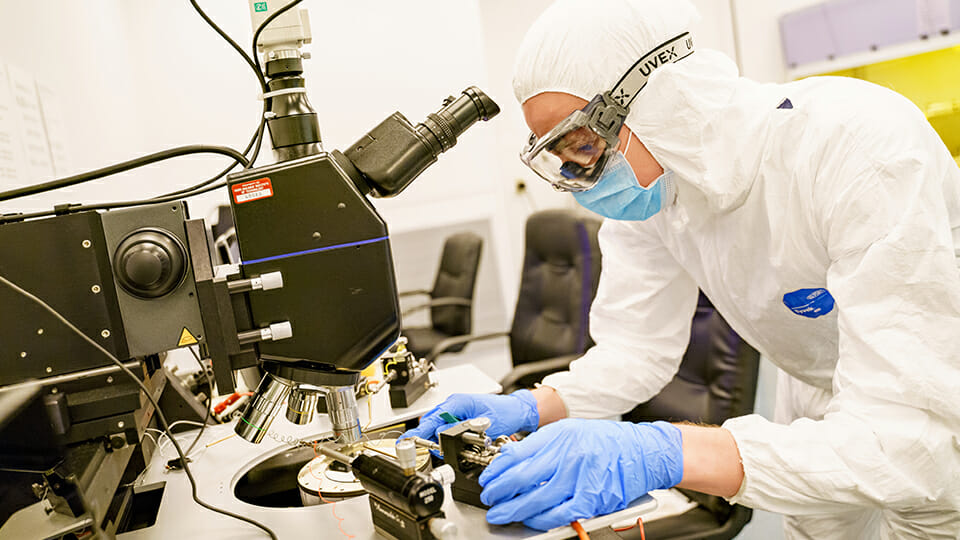Rose-Hulman partnering on semiconductor education, training update
Subscriber Benefit
As a subscriber you can listen to articles at work, in the car, or while you work out. Subscribe Now
Rose-Hulman Institute of Technology this week announced a partnership with the University of Illinois Urbana-Champaign and Stanford University to support the country’s growing semiconductor industry. Through the Higher Educational Initiative in Integrated Device Manufacturing, or HIVE, the partners aim to update semiconductor manufacturing and microelectronics curricula.
“Our goal is to basically create a semiconductor training ecosystem that will use hands-on practices for training engineers and technicians for the semiconductor industry,” said Dr. Azad Siahmakoun, professor of physics and optical engineering at Rose-Hulman.
Siahmakoun, who is also the founding director of Rose-Hulman’s MiNDS cleanroom facility, told Inside INdiana Business the recently-passed CHIPS and Science Act will create a need for more technicians and engineers.
“We’re looking at retraining people and as well as training new students in that area to help with this expansion. The goal is to go beyond manufacturing of 10% of microelectronics and semiconductor devices made in the world,” Siahmakoun said. “And the U.S. needs to do that for a couple of reasons: One, as is highlighted in the CHIPS Act, for economic development and of course, more importantly, for national security.”
The initiative aims to connect researchers and educators from the three schools together with industry partners to develop pathways that could impact students through not only coursework, but broader engagement and training opportunities.
Siahmakoun said the combination of the three institutions through their knowledge of semiconductors and microelectronics will ensure HIVE’s success.
“UIUC and Stanford are leaders of R&D in semiconductor devices and manufacturing, and, of course, Rose-Hulman, we [are] predominantly an educational system,” he said. “So, it’s an ideal partnership, where we could actually use the best practices to enhance our capability to train in both areas of education and research. So, that’s the goal.”
Rose-Hulman has had a program surrounding semiconductor materials and devices since 1997, and later added a cleanroom facility, known as the Micro-Nanoscale Devices & Systems, or MiNDS, in which students can participate in manufacturing semiconductor devices.
However, Siahmakoun said the university needs to update its programs.
“We need to move forward in several areas of integrated circuits and high speed, high performance devices, as well as the new generation of silicon chips that involves photonics,” he said. “Photonic integrated circuits are coming very fast and is going to change basically the devices we have today and create new devices that we don’t presently have in the market.”
Rose-Hulman plans to update its certificate program and hands-on physics, optical engineering, electrical engineering, and computer engineering curricula to meet future semiconductor industry demands.
Also as part of the HIVE program, Siahmakoun will develop workshops for students and faculty aimed at increasing skill development through training in device design, layout, fabrication, characterization, and testing semiconductor devices and silicon-based photonic integrated circuits, with an emphasis on skills needed by industry partners in the workforce, Rose-Hulman said.
The partners plan to spend the next year and a half to put together a package of best practices and updated curricula that can then be digitally disseminated to other institutions throughout the world.
President Biden signed the CHIPS and Science Act last August, appropriating nearly $53 billion to support companies building semiconductor manufacturing plans in the U.S., as well as R&D and workforce development initiatives in the industry.
Indiana has already seen its share of semiconductor growth, with the planned $1.8 billion semiconductor R&D and production facility in West Lafayette from Minnesota-based SkyWater Technology (Nasdaq: SKYT), as well as an $84 million microelectronics campus at WestGate@Crane Technology Park.
Just last week, Massachusetts-based nonprofit engineering innovation company Draper opened an office at WestGate designed to help the company’s plans to pursue opportunities funded by the CHIPS and Science Act.
Siahmakoun said he hopes the efforts from HIVE will support Indiana’s growing semiconductor ecosystem.
“Those manufacturing or testing or designing companies will need engineers that could move their goals forward, and we’re hopeful that we we will contribute to their needs.”
